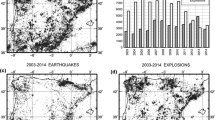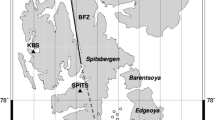Abstract
The International Data Centre (IDC) routinely applies event screening using a multi-technology approach in order to enable member states to characterize events as either natural or anthropogenic. Various event discriminants are presented in literature. At the Kenya National Data Centre (KE-NDC or N090), a systematic and step-by-step procedure of SEISMIC events discrimination is applied. Results from the discriminants adopted are obtained within a short time and the discriminants are relatively easy and fast to use. The discriminants used at KE-NDC (N090) are ranked in a hierarchy based on results obtained from one discriminant being applied in subsequent discriminants and ease of returning results within the shortest time possible to allow for events discrimination and dissemination of results. The discriminants applied and their hierarchy at KE-NDC include: (i) event location (epicenter/hypocenter parameters) (ii) hypocenter parameters based on events relocation using HYPOCENTER, (iii) magnitude determination, (iii) mb:Ms criteria and (iv) focal mechanism determination. Two seismic events are used as case examples to demonstrate how event discrimination is achieved based on the discriminants presented herein. The two seismic events are the 20190324 and 20200503 seismic events in southwestern and northern Kenya respectively. The choice of these two events is based on the fact that they were strong enough to be recorded by a number of global seismic stations and their magnitudes are comparable to the 2009, 2013 and 2016, but slightly lower than the 20170903 DPRK announced tests. Based on the discriminants used and presented herein, the two seismic events were categorized as being due to natural earthquakes.






Similar content being viewed by others
Data availability
All the data used in the current study is publicly available from the CTBTO to all CTBT member states. In addition, IRIS, NEIC and USGS data is also available to all scientists and an acknowledgement of the data source is critical.
Change history
03 June 2024
A Correction to this paper has been published: https://doi.org/10.1007/s00024-024-03495-z
References
Allmann, B. P., Shearer, P. M., & Hauksson, E. (2008). Spectral discrimination between quarry blasts and earthquakes in Southern California. Bulletin of the Seismological Society of America., 98, 2073–2079.
Bath, M. (1983). Earthquake frequency and energy in Greece. Tectonophysics, 95(3–4), 233–252.
Baumgardt, D. R., & Young, G. B. (1990). Regional seismic waveform discriminants and case-based event identification using regional arrays. Bulletin of the Seismological Society of America., 80, 1874–1892.
Blandford, R. R. (1977). Discrimination between earthquakes and underground explosions. Annual Review of Earth and Planetary Sciences, 5, 111–122.
Bowers, D., & Selby, N. D. (2009). Forensic seismology and the comprehensive nuclear-test-ban treaty. Annual Review of Earth and Planetary Sciences, 2009(37), 209–236.
Cheng, Y., Wang, X., Zhan, Z., & Zion, Y. B. (2021). Isotropic source components of events in the 2019 Ridgecrest, California, earthquake sequence. Geophysical Research Letters, 48, e2021GL094515. https://doi.org/10.1029/2021GL094515
Craig, T. J. (2019). Accurate depth determination for moderate-magnitude earthquakes using global teleseismic data. Journal of Geophysical Research, 124(2), 1759–1780.
CTBTO Prep Comm. (1996). Comprehensive Nuclear Test-Ban Treaty (CTBT). CTBTO.
CTBTO Prep Comm. (2013). Geotool software User tutorial. CTBTO IDC/SA/SI.
CTBTO Prep Comm. (2015). Guide book for IDC Users on IMS data IDC Products and Technical Assistance Available to States Signatories. CTBTO.
CTBTO Prep Comm. (2020). IDC Processing of Seismic, Hydroacoustic and Infrasonic (SHI) data. CTBTO.
Douglas, A., Hudson, J. A., Marshall, P. D., & Young, J. B. (1974). Earthquakes that look like Explosions. Geophysical Journal International, 36, 227–233.
Dysart, P. S., & Pulli, J. J. (1990). Regional seismic event classification at the NORESS array: Seismological measurements and the use of trained neural networks. Bull. Seism. Soc. Am., 80(6B), 1910–1933.
Fisk, M. D., Jepsen, D., & Murphy, J. R. (2002). Experimental seismic event-screening criteria at the Prototype International Data Center. Pure and Applied Geophysics, 159, 865–888.
Havskov, J., & Ottemoller, L. (1999). SEISAN Earthquake analysis software. Seismological Research Letters., 70(5), 532–534.
Horasan, G., Güney, A. B., Küsmezer, A., Bekler, F., Öğütçü, Z., & Musaoğlu, N. (2009). Contamination of seismicity catalogs by quarry blasts: An example from Istanbul and its vicinity, northwestern Turkey. Journal of Asian Earth Sciences, 34, 90–99.
Jeffreys, H., & Bullen, K. E. (1967). Seismological Tables (p. 50). British Association for the Advancement of Science.
Kafka, A. L. (1990). Rg as a depth discriminant for earthquakes and explosions: A case study in New England. Bulletin of the Seismological Society of America., 80(2), 373–394.
Kenneth, L. N., & Engdahl, E. R. (1991). Traveltimes for global earthquake location and phase identification. Geophysical Journal International, 105(2), 429–465.
Kiszely, M., Süle, B., Mónus, P., & Bondár, I. (2021). Discrimination between local earthquakes and quarry blasts in the Vértes Mountains, Hungary. Acta Geodaetica Et Geophysica, 56, 523–537. https://doi.org/10.1007/s40328-021-00346-4
Koch, K. (2002). Seismic event identification of earthquakes and explosions in germany using spectral Lg ratios. Pure and Applied Geophysics, 159, 759–778.
Li, J., Zhu, W., Biondi, E., & Zhan, Z. (2023). Earthquake focal mechanisms with distributed acoustic sensing. Nature Communications. https://doi.org/10.1038/s41467-023-39639-3
Lienert, B. R. (1994). HYPOCENTER 3.2: A computer program for locating earthquakes locally, regionally and globally (p. 74). Hawaii Institute of Geophysics and Planetology.
Lienert, B. R., Berg, E., & Frazer, N. (1986). HYPOCENTER: An earthquake location method using centred, scaled and adaptively damped least squares. Bulletin of the Seismological Society of America., 76(3), 771–783.
Lienert, B. R., & Havskov, J. (1995). A computer program for locating earthquakes both locally and globally. Seismological Research Letters., 66(5), 26–36.
Pomeroy, P. W., Best, W. J., & McEvilly, T. V. (1982). Test ban treaty verification with regional data—a review. Bulletin of the Seismological Society of America., 72, 89–129.
Selby, N. D., Bowers, D., Douglas, A., Heyburn, R., & Porter, D. (2005). Seismic Discrimination in Southern **njiang: The 13 March 2003 Lop Nor Earthquake. Bulletin of the Seismological Society of America., 95(1), 197–211.
Snooke, J. A. (2003). FOCMEC: FOCal MEChanism determinations (pp. 1–21). Virginia Tech.
Snooke, J. A. (2017). FOCMEC: FOCal MEChanism determinations. International Geophysics., 81, 1629–1630. https://doi.org/10.1016/S0074-6142(03)80291-7
Su, F., Aki, K., & Biswas, N. (1991). Discriminating quarry blasts from earthquakes using coda waves. Bulletin of the Seismological Society of America., 81(1), 162–178.
Taylor, S. R., Denny, M. D., Vergino, E. S., & Glaser, R. E. (1989). Regional discrimination between NTS explosions and western U S Earthquakes. Bulletin of the Seismological Society of America., 79, 1142–1176.
Vaněk, J., Zatopek, A., Kárník, V., Kondroskaya, N.V., Riznichenko, Y.V., Savarensky, E.F., Solov’er, S.L., & Shebalin, N.V. (1962). Standardization of magnitude scales. Izu Acad. Sci. USSR Geophys. Ser., pp 108–111.
Wei, F., & Li, M. (2003). Cepstrum analysis of seismic source characteristics. Acta Seismologica Sinica, 16(1), 50–58.
Wüster, J. (1993). Discrimination of chemical explosions and earthquakes in central Europe—a case study. Bulletin of the Seismological Society of America., 83, 1184–1212.
Yılmaz, Ş, Bayrak, Y., & Çınar, H. (2013). Discrimination of earthquakes and quarry blasts in the eastern Black Sea region of Turkey. Journal of SeismoLogy., 17, 721–734.
Acknowledgements
The support from the Comprehensive Nuclear Test-Ban Treaty Organization (CTBTO) to CTBT member states for the establishment of National Data Centres and continuous support to national technical experts through trainings and capacity building in the CTBT’s verification regime is greatly appreciated. The author further expresses his profound gratitude to two anonymous reviewers for their careful reviews and constructive suggestions in improving the manuscript.
Funding
The authors have not disclosed any funding.
Author information
Authors and Affiliations
Contributions
The results of seismic event discrimination at KE-NDC were presented during the Comprehensive Nuclear Test-Ban Treaty (CTBT) Science and Technology Conference 2023 (SNT2023) which was held from 19 to 23 June 2023 at the Hofburg Imperial Palace in Vienna, Austria. The author’s contribution is outlined below: Josphat Kyalo Mulwa (JKM): JKM is the sole author of this paper and is involved in routine analysis of seismic events at the Kenya National Data Centre (KE-NDC). IMS data from four seismic stations is received on continuous basis at KE-NDC. Additional data was requested by JKM from the IDC in Vienna, and these together with the continuous data forms part of the data used in this and other studies at KE-NDC. Waveform data from non-IMS seismic stations is requested from either IRIS or FDSN in SAC format. The analysis of waveform data, application of the seismic event discriminants and the write-up of this paper were done solely by JKM. JKM presented the results of this work during the CTBT Science and Technology conference (SNT2023) in Vienna, Austria. Based on the SNT2023 presentation, JKM was called upon and requested by the Provisional Technical Secretariat (PTS) to prepare and submit a full paper for publication in Pure and Applied Geophysics (PAGEOPH) Journal Topical Issue on “Nuclear Explosion Monitoring and Verification: Scientific and Technological Advances”. On the basis of this call for papers, JKM has written this manuscript based on his expertise seismology and taking into consideration the mandate of the CTBTO and the obligations of CTBT member states.
Corresponding author
Ethics declarations
Conflict of Interest
The authors have not disclosed any competing interests.
Additional information
Publisher's Note
Springer Nature remains neutral with regard to jurisdictional claims in published maps and institutional affiliations.
Rights and permissions
Springer Nature or its licensor (e.g. a society or other partner) holds exclusive rights to this article under a publishing agreement with the author(s) or other rightsholder(s); author self-archiving of the accepted manuscript version of this article is solely governed by the terms of such publishing agreement and applicable law.
About this article
Cite this article
Mulwa, J.K. Systematic Seismic Events Discrimination Methods at the Kenya National Data Centre (N090). Pure Appl. Geophys. (2024). https://doi.org/10.1007/s00024-024-03458-4
Received:
Revised:
Accepted:
Published:
DOI: https://doi.org/10.1007/s00024-024-03458-4




